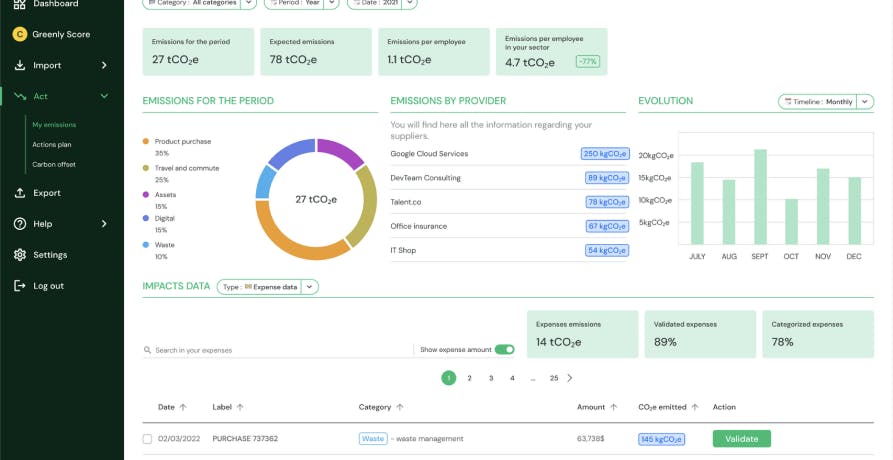
What are the 3 Pillars of Corporate Sustainability?
In this article, we'll explore what the 3 pillars of corporate responsibility are, why they're important, and how businesses can turn them into practical action.
ESG / CSR
Industries



We're all aware how we have to reduce our global greenhouse gas emissions in order to fight global warming, but how many are aware that much of this starts with learning to measure my [our] carbon footprint – or the carbon footprint created by our company?
In this context, being aware of your carbon footprint will help you understand how to contribute to fighting against global warming.
This is because learning how to calculate carbon footprint for natural gas, transportation emissions, and even a household's carbon footprint can help determine which energy efficiency tactics, life cycle assessment or carbon offsets can help reduce the energy consumed, improve overall fuel economy, and reduce average estimates our global ecological footprint to fight climate change.
👉 But how can you precisely measure your carbon footprint and learn, "how to measure my carbon footprint"?
In this article, we'll explain what a carbon footprint is, different calculation methods to calculate your carbon footprint, and how companies and individuals can reduce their carbon footprint.
A carbon footprint refers to the total amount of greenhouse gas or carbon emissions created as a direct result of our daily activities, such as eating, getting to school and work, purchasing goods and services, power plant usage, or even traveling.


Carbon reduction methods are taking new precedent as our, often negative, ecological footprint serves a way to encourage us to tackle climate change moving forward – such as by seeking to conserve raw materials and reduce our energy consumption. In addition to this, carbon management has become imperative for businesses around the world if they wish to continue pleasing their customers, employees, and stakeholders.
👉 Overall, seeking to make carbon footprint calculation can help us to reduce direct emissions, indirect emissions, GHG emissions, improve energy efficiency within our homes and offices, and evade the overall climate crisis.
A carbon footprint is an indicator that accounts for GHGs (greenhouse gases) emitted by human activity. Their concentration in the atmosphere traps solar radiation refracted onto the earth's surface. They are thus partly responsible for global warming.
A carbon footprint is expressed in carbon dioxide equivalent (CO₂e). GHGs all have a different global warming power (GWP). This indicator is therefore a way of standardizing the reading of these impacts since they are expressed as a volume of CO₂ retaining the same amount of solar radiation.
Remember, the increase in our global carbon footprint calculations is a direct result of human activities, large companies paying little attention to their emissions of the three scopes of emissions, failing to abide by the Paris Agreement, and simply a lack of interest in reducing emissions as a whole.
👉 Learning how to measure my carbon footprint (or our collective carbon footprint) is contingent on understanding the before, during, and after processes and procedures when completing a carbon footprint assessment.

There are three types of greenhouse gases:
These emissions come from various business activities and human practices, such as the combustion of fossil fuels (oil, gas, coal), deforestation, intensive agriculture, mining (extraction of metals for the manufacture of batteries, jewellery, etc.), and other activities that could result in other indirect emissions caused by business activity.
👉 If I want to measure my carbon footprint, it will be necessary to gather data on the collective amount of greenhouse gas emissions produced from various entities throughout my business or personal daily activities.
The IPCC (Intergovernmental Panel on Climate Change) has identified over 40 greenhouse gases. The GHGs with the highest emissions are the following:
"Carbon footprint" and "carbon footprint report" are two closely related concepts, but they do not refer to the same thing. The carbon footprint is the trace of GHGs that we leave behind in our production and consumption. The carbon footprint report, on the other hand, is the analysis of the GHGs emitted by our various activities.
In other words, it allows us to take inventory of the CO₂ generated by each of our actions. As a result, this is also a means of targeting the areas where reducing your carbon footprint is necessary.
👉 If I measure my carbon footprint, or the carbon footprint created in my personal life – it will most likely not ever need to be included in a carbon footprint report, as those are more garnered towards businesses.
To calculate our personal carbon footprint, the EPA has shared an online tool and calculator to help those wishing to pursue green living practices take this first step in their new sustainable journey. This tool can help people calculate the carbon emissions created in their own household and provide additional free resources and ideas on how to cut back on their carbon emissions.
However, beyond online tools or resources provided to help companies in achieving net zero, decarbonizing their value chain, or even encouraging the average person to take public transport over driving – there are several more methodologies used to determine how much companies and individuals emit greenhouse gases and other indirect emissions.
There are numerous different methods to calculating carbon footprints, such as via the use of physical ratios, monetary ratios, and the use of online tools to calculate your carbon footprint and enhance carbon monitoring.
Here are the different ways to calculate and track your environmental footprint:
In the case of a physical emission factor, the amount of CO₂ released per unit consumed can be specified. This applies to transport or agricultural production, among others. For example, consuming a full tank of petrol (50 liters) is equivalent to emitting 114 kg (251 pounds) of CO₂.
💡 Therefore, if I want to measure my carbon footprint – I would have to know the amount of carbon dioxide released per unit in order to make an accurate calculation.
A monetary emissions factor allows the CO₂ content generated by a product or service to be estimated from its price. It is expressed in kg CO₂e / K $ excluding tax, and applies to activities and products that cannot be calculated using physical factors –such as with an iPhone, computer, or other electronic product.
These calculation methods are still complicated, especially when it comes to monetary factors. Various organizations have developed online tools, such as a carbon calculator, to help us assess our GHG emissions.
Here are some of them:
It is important to note that while these tools may provide information on all three categories for scope emissions, it is extremely challenging for businesses to successfully reduce their scope 3 emissions – which is why the Greenhouse Gas Protocol often constitutes calculating scope 3 emissions as optional.
This is also one example of why many companies will refer to the use of carbon offsetting to help compensate for difficult to reduce emissions.
👉 If I want to measure my own carbon footprint, a lot of math is usually involved due to money calculations – which is why many people seek to use carbon footprint calculators.
From Karbon to measure the carbon footprint of our food to 90 days to help us improve our impact on the environment, many applications to calculate our carbon footprint have emerged in recent years.
However, the most innovative approach is the one proposed by Greenly: the automatic calculation of CO₂ emissions based on bank spending.
In fact, Greenly's calculator is based on each of your expenses to categorize them and indicate their precise environmental impact. Therefore, you can have greater insight on your CO₂ emissions from your telephone subscription, your car journeys or your lunch.

In order to calculate your carbon footprint as accurately as possible, Greenly has set up a system for tagging your expenses.
You can specify a purchase by assigning it a label which will then allow it to be categorized and its impact calculated. This tagging system allows you to develop optimal calculation coefficients for each categorized expense.
If I don't want to measure my carbon footprint, but the footprint of my business – that's possible too.
💡 In fact, reporting your corporate carbon footprint has never been more essential – as by 2026, all large U.S. companies will be required to share their scope 1 and scope 2 emissions, as this has been deemed as imperative to investors.
Jean-Marc Jancovici, a climate engineer, and ADEME have developed a reliable method for drawing up a carbon balance. It consists of accounting for all the GHG emissions of a product or service consumed over the course of its existence.
Greenly's methodology is based on two aspects:
👉 This data can then provide an accurate indication of your carbon footprint and help you reduce it.
Regulatory GHG balance, or "simplified carbon footprint" – reports on direct greenhouse gas emissions and indirect energy-related emissions. It is compulsory for a certain number of public and private actors to carry out this assessment.
ADEME also recommends that a balance sheet be drawn up for indirect emissions not related to energy, as these are in the majority in companies.
A simplified carbon footprint report in the United States is mandatory under the new SEC Climate Disclosure Rule and other new regulations for :
💡 Remember, the United States has required entities that emit 25,000 metric tons or more of carbon dioxide to report their GHG emissions to the Environmental Protection Agency every year since 2009!
There are a multitude of reasons why it is well worth your time and effort to calculate your carbon footprint, such as by helping to improve your brand image and to attract new clients or investors.
Here are just a few reasons why seeking to measure and reduce your carbon emissions is a valuable tactic for everyone involved:
Beyond the obvious reasons to measure your carbon footprint to fight against climate change, a full carbon footprint can be beneficial for businesses for several reasons, such as:
Most importantly, it is a way to get ahead of future legislative changes and comply with them more easily in the future. The CCC (Citizens' Climate Convention) suggests that companies be obliged to provide an annual carbon report. It even proposes the application of financial penalties if a company's carbon or GHG emissions change.
Carrying out a certified corporate carbon footprint takes time and expertise. It is therefore advised to entrust a trusted professional. However, this process can be very costly depending on the type of service provider chosen.
To do this, companies can therefore call on a specialized firm to calculate their emissions. Specialized firms also offer to draw up their clients' CSR strategy. However, offering their services comes at a significant cost – as conducting a company's carbon footprint generally costs thousands of dollars.
Simple and east-to-use, Greenly's online management tool is 5 times less expensive than a specialist consultant. It synchronizes with the company's bank account to provide an automatic and accurate report. Greenly thus offers tailor-made plans and solutions adapted to companies in order to efficiently build up their carbon footprint and reduce their GHG emissions.

The carbon footprint in the United States totaled in at a whopping 4.8 billion metric tons in 2023 alone. Despite the fact that this was a 1.8% decline compared to the previous year, this still isn't a large enough drop for the United States to make a dent in the fight against climate change.
Here are the largest culprits behind the massive carbon footprint created by the United States:
Here's a table fully breaking down the emissions on behalf of the United States:
| Sector | Emissions (%) |
|---|---|
| Transportation | 28.4% |
| Electricity | 24.9% |
| Industry | 22.9% |
| Agriculture | 10.0% |
| Commercial | 7.3% |
| Residential | 6.2% |
| U.S. Territories | 0.4% |
As of 2023, the ten countries with the highest CO2 emissions are
Note that when considering the footprint per capita, Qatar comes first...
Fortunately, reducing one's carbon footprint is easier than one might think, thanks to the online tools available to both individuals and businesses.
Here are some of the ways your business and household alike can reduce your emissions:
💡 The first step to reducing your emissions is to identify your biggest consumption factors: such as how often your drive or eat meat on a weekly basis.
With online tools such as GoodPlanet or Ecolab (ADEME), you can estimate your biggest sources of GHG emissions that will impact your carbon footprint.
However, Greenly's application remains the most suitable to reduce your carbon footprint on a daily basis in an efficient way. As a result of bank synchronization, your GHG emissions are calculated in real time according to your expenses. Eco-responsible alternatives are then proposed for each of them.
Consuming better to protect the planet becomes easier. Tempting, isn't it?
Simple practices that you can incorporate into your daily life can also reduce your carbon footprint and your CO₂ emissions:
By adopting a few of these practices, you will already contribute a massive helping hand in the effort to ensure environmental preservation.

These practices are part of a sustainable and therefore a more responsible method and lifestyle of consumption.
To better understand what we mean by the term sustainable consumption, here is the concept broken down into 3 main points:
💡 Sustainable consumption in everyday life is possible by favoring certain products and practices:
Applications to combat food waste have also emerged. For example, Phénix or To Good To Go allow people to buy food products that are close to their use-by date and therefore need to be removed from the shelves at low prices.
👉 Finally, the second-hand market is a good way to consume in a sustainable way. Sites such as eBay, Vinted for clothes or Craigslist for reconditioned electronic products make it possible to buy at low prices in a responsible way.
Sustainable living also concerns the financial world.
Sustainable finance is based on an ethical vision of investment and savings. Its aim is to achieve economic performance with positive social and environmental impacts.
Several mobile applications have been developed for this purpose, such as Rift – which allows users to see how their savings are invested and to measure their carbon impact.
Banks also offer sustainable financing through different models: green finance, social business or SRI (socially responsible investment). Your banker will be able to guide you in the best way to save and invest on request.
Do you want to invest without too much effort? ETFs are the solution. These baskets of shares allow you to diversify your investments simultaneously. Thanks to EFT selectors such as Ark Invest or Track Insight, you can target those that focus on companies' environmental strategies. You can also focus on future environmentally friendly innovations.
Robo-advisors are an even simpler way to make positive impact investments. These robo-advisors manage your stock portfolio in an automated way. You then choose how much of your portfolio you want to invest in responsible investments.
Some examples include:
If you want to have full control over your investments, you can of course choose which projects to invest in yourself. You can do this by using traditional investment platforms that measure the environmental impact of the projects. Alternatively, you can opt for platforms such as Miimosa that offer to invest in environmental projects related to agriculture and food.
Targeting the most important emission points and adopting alternative means to reduce their activity, while providing access to the data, is the most appropriate solution for them. This is especially true as they involve a number of people and devices (digital, electrical, etc.). Reducing the carbon footprint is therefore of particular concern to them.
To do this, they must turn to a service provider authorized to carry out a carbon assessment according to the ADEME method, such as with Greenly.
The idea of carbon offsetting is to set up "carbon sinks" to absorb the emissions emitted in order to achieve carbon neutrality. This can be achieved through investment in renewable energy or by planting trees, for example.
Greenly is particularly committed to this offsetting approach, both locally and internationally, through the various mobilization projects it has set up:
Offsetting does not mean that reducing our carbon footprint is not necessary. It is a complementary response to the environmental issues we face today.
Now that you know all about the carbon footprint, will you become a player in environmental protection? It's up to you to act today to reduce your carbon footprint tomorrow.
If reading this article about how to measure your carbon footprint has made you interested in reducing your carbon emissions to further fight against climate change – Greenly can help you!
For a deeper understanding of product impact, check out Life Cycle Analysis
Greenly can help you make an environmental change for the better, starting with a carbon footprint assessment to know how much carbon emissions your company produces.
Click here to learn more about Greenly and how we can help you reduce your carbon footprint.
